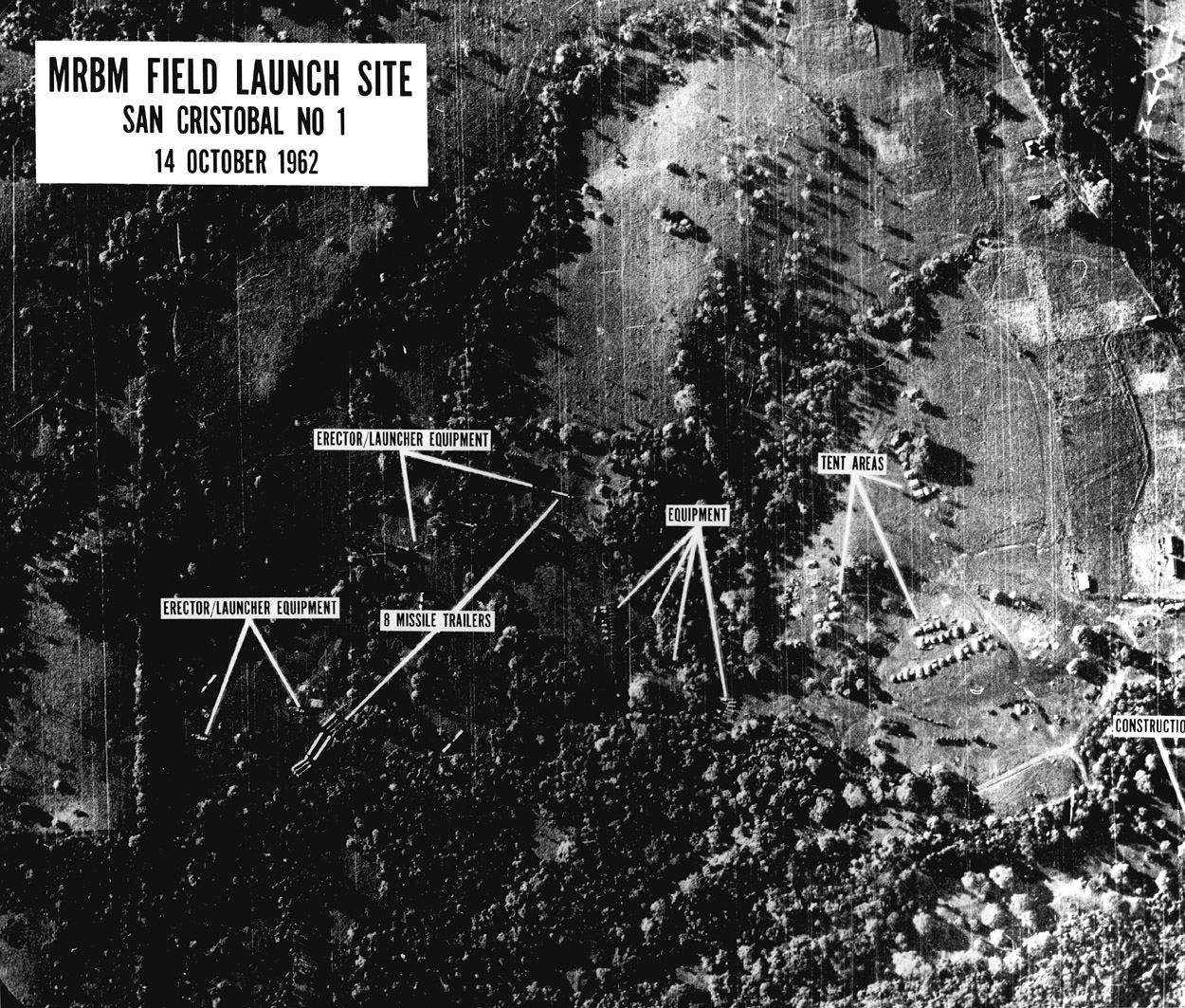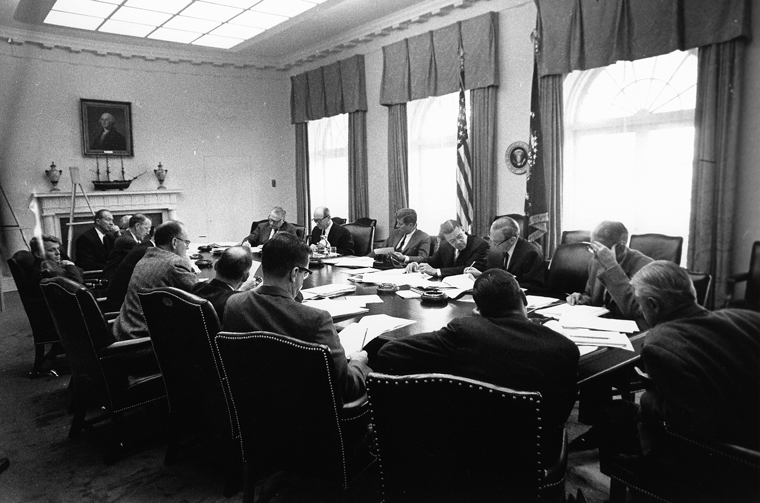The Cuban Missile Crisis: A Timeline
October 16-28 marks the anniversary of the Cuban Missile Crisis, an anxious period during the Cold War in which the world’s two superpowers — the United States and Soviet Union — stood on the brink of a nuclear war. Just 17 years after the bombings of Hiroshima and Nagasaki, a stark warning of the devastating consequences of launching a nuclear warhead, fear of nuclear conflict was at America’s doorstep. Over the course of 13 days, the world avoided nuclear catastrophe through shrewd diplomacy and sheer luck.
October 16, 1962: U.S. National Security Advisor McGeorge Bundy briefs President John F. Kennedy on evidence the Soviets are constructing nuclear missile sites in Cuba, just 90 miles from U.S. territory. Earlier that year, Soviet leader Nikita Khrushchev had reached a secret agreement with Cuban leader Fidel Castro after the island experienced a failed U.S. attempt to overthrow the government.

President Kennedy meets with a group of trusted advisors to discuss options. This group would meet daily during the crisis and later be named the Executive Committee of the National Security Council or ExComm. Two main options emerge: destroying the Soviet missile sites with air strikes or establishing a naval blockade to cut off Soviet shipments of additional materials to Cuba.
October 20, 1962: Following days of meetings, including one with Soviet Foreign Minister Andrei Gromyko, Kennedy decides on a naval blockade.
October 22, 1962: Kennedy addresses the American public revealing the news of Soviet moves in Cuba and announcing the U.S. establishment of a naval quarantine until the Soviets dismantle the missile sites. He also sends a letter to Khrushchev, warning him of “deliberately plung[ing] the world into war which it is crystal clear no country could win and which could only result in catastrophic consequences to the whole world, including the aggressor.”
October 23, 1962: U.S. ships move into place around Cuba. Soviet freighters bringing supplies to the island move into the area but ultimately alter course or stop in their place.
October 25, 1962: Soviet freighters turn back toward Europe but a commercial oil tanker — the Bucharest — continues toward Cuba. The U.S. allows the Bucharest to pass through the blockade without search after the Navy was satisfied it was carrying petroleum.
October 26, 1962: As work on the missile sites continues, Castro requests Khrushchev launch a nuclear first strike against the U.S. This never happens. Instead, the Soviet leader sends a letter to President Kennedy suggesting a way to resolve the conflict: the Soviets would remove the missiles in exchange for a U.S. pledge not to invade Cuba.
Kennedy’s brother, Attorney General Robert Kennedy, plays a crucial role in diplomatic efforts, meeting with Russian Ambassador Anatoly Dobrynin who likens the Soviet buildup in Cuba to the U.S. nuclear missiles stationed in Turkey. AG Kennedy informs Dobrynin the United States is ready to discuss the issue as part of a potential agreement to end the crisis.
Soviet Premier Nikita KhrushchevThe two most powerful nations had been squared off against each other, each with its finger on the button.You'd have thought that war was inevitable. But both sides showed that if the desire to avoid war is strong enough, even the most pressing dispute can be solved by compromise.
October 27,1962: On what has come to be known as “Black Saturday,” a U.S. reconnaissance plane is shot down over Cuba and the pilot, Major Rudolf Anderson, is killed, prompting President Kennedy to say, “We are now in an entirely new ball game.”
In the Caribbean, U.S. ships drop depth charges (explosions) to the left and right of a Soviet submarine as a warning and to force it to the surface. Unbeknownst to the Americans, the submarine was carrying a nuclear weapon and, believing a war had started, the Soviets prepared to launch. Three officers were needed to greenlight the launch. One refused. Vasili Arkhipov saved the world from nuclear disaster.
Meanwhile, negotiations continue between the U.S. and Soviets in sincere efforts to find a solution to the crisis before it escalates to sustained conflict.
October 28, 1962: Khrushchev publicly announces the Soviets would dismantle the missile sites in exchange for United States assurance it would not invade Cuba without direct provocation. Dismantlement begins later that afternoon.

The naval blockade formally ended on November 20, 1962 after the Soviets agreed to remove their bombers from Cuba. In accordance with the secret U.S.-Soviet agreement, U.S. missiles were removed from Turkey in April 1963.
The crisis ended and it was clear to both the Soviet Union and the United States just how close they had come to nuclear conflict and how necessary communication was in avoiding catastrophe. In the words of Khrushchev: “The two most powerful nations had been squared off against each other, each with its finger on the button.” To prevent similar situations from taking place, a direct nuclear hotline was created between the U.S. and the Soviets to improve transparent communication. In addition, the signing of the Limited Test Ban Treaty in 1963 banned further nuclear testing in the atmosphere, outer space and under water.
Despite reductions in nuclear arms (from 70,300 in 1986 to 14,485 in 2018), the risk of nuclear-armed countries engaging in conflict that could escalate to nuclear use remains very real. Kennedy and Khrushchev deserve credit for de-escalating through diplomacy, but we cannot discount the role of luck in leading the U.S. and Soviets out of the crisis in Cuba unharmed. We cannot count on diplomatic prowess or luck forever. As long as nuclear weapons exist, the world will be at risk of nuclear conflict with global ramifications. The only way to eliminate the risk is to eliminate the weapons.